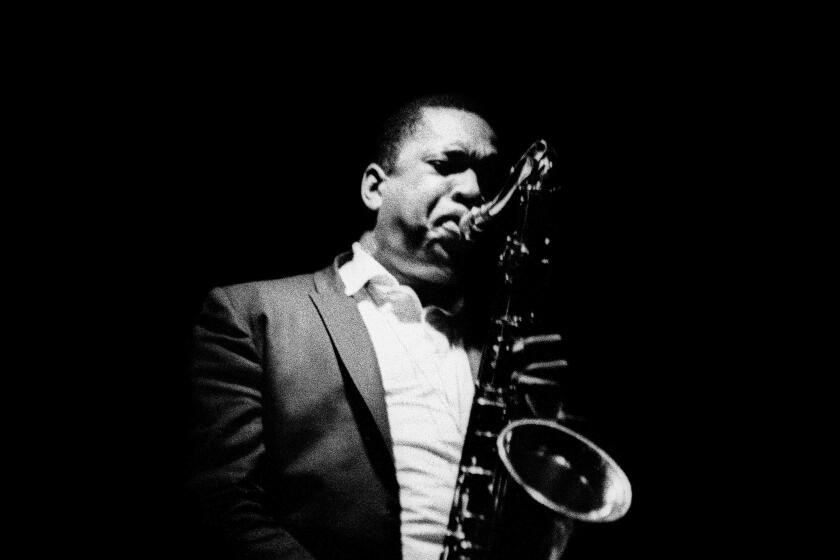His Atlantic Records shaped pop music
- Share via
Ahmet Ertegun, the Turkish ambassador’s son whose ear for the culture of black America would make his Atlantic Records a legendary fount of 20th century popular music, died Thursday. He was 83.
Ertegun had slipped into a coma after suffering a head injury in an October fall backstage at a Rolling Stones show celebrating the 60th birthday of former President Clinton. Ertegun never recovered from the severe trauma of the injury, said Dr. Howard A Riina, the attending neurosurgeon at New York Presbyterian Hospital, and died with his family at his bedside.
Ertegun was a true titan of the music industry across decades -- his upstart Atlantic label became the home of R&B; music in the 1950s with Ray Charles, Big Joe Turner, Ruth Brown, the Drifters and the Coasters and then triumphed on new turfs in the 1960s and 1970s with signature acts such as Aretha Franklin; Led Zeppelin; Cream; Yes; Crosby, Stills, Nash & Young; and Sonny & Cher.
But more than a mogul, Ertegun was a passionate connoisseur of music who was beloved by many of his artists and peers for his personal panache and his encyclopedic knowledge of music, especially jazz and rhythm and blues.
“Ahmet had as much fun as any man alive,” Stephen Stills of CSN&Y; said Thursday. “He started out doing what he loved, and he did it all his life. He also brought America’s black and white cultures together through music and helped cure the cancer of racism we had on our hearts.”
Ertegun was a founder of the Rock and Roll Hall of Fame and remained chairman of Atlantic Records until his death. He was also an enthusiastic presence at concerts and industry events, such as the Stones’ performance for Clinton at the Beacon Theatre in Manhattan.
News that he had died brought an outpouring of sentiment from veterans of the music industry. And, even for a business circle inured to hyperbole, there was a strong consensus that an era had come to an end with the death of Atlantic’s architect.
Ertegun started Atlantic Records in 1947 with a fellow jazz fan, Herb Abramson, as a partner and with a $10,000 loan they got from a family dentist. The label became a 1950s sensation by delivering earthy R&B; and lively jazz that corporate labels were too slow or too timid to embrace.
“He was a visionary.... He was one of the great personalities of our time, moving from Jagger to Kissinger, from Ray Charles to Brooke Astor,” said Clive Davis, the founder of Arista Records who now heads J Records and is chief executive officer of BMG North America. “His passion for music was singular, and his contribution to our musical heritage was second to none.”
Ertegun’s legacy was spun not only in platinum and gold records but also in the careers of others who looked to Atlantic as the template for independent label success and to Ertegun as a charismatic hero.
David Geffen, the billionaire entertainment mogul, said Thursday that it was at Ertegun’s advice that he first launched his own label. Geffen said Ertegun’s personality was as potent as his business acumen. “He loved musicians, he loved music, he loved life.... He was a lot of fun, a real raconteur,” Geffen said. Of his friend’s storytelling, Geffen said: “He was elegant and raunchy.”
In the music-industry book “Hit Men” in 1991, author Fredric Dannen described Ertegun as a winking and worldly player: “He had Great Record Man written all over him. He was jaunty, and bald, and had a goatee.... He could order a bottle of wine from a headwaiter in perfect French, then turn to his jazzman dinner guest and slip into black jive. Ertegun was one of the original characters of the record business, but the one with the most class.”
He was born July 31, 1923, in Uskudar, a dense suburb of Istanbul that lies on the Bosporus. The family didn’t take the name Ertegun until 1936, when President Mustafa Kemal Ataturk decreed that all Turkish families should adopt surnames. The future mogul’s father, a lawyer and diplomat named Mehmet Munir, chose “Ertegun”; it means “living in a hopeful future.”
Passion for music
It was his mother, Hayrunisa Rustem, who gave Ertegun a passion for music.
“If it hadn’t been for the mores of Turkish society, she probably would have been a star,” he once wrote. “She had a beautiful voice, played every instrument by ear, was a terrific dancer and loved music. Wherever we were, she always bought all the popular hits of the day: Josephine Baker, Mae West, the Mills Brothers, the Boswell Sisters, among many others, so we always had a lot of music in the house.”
His father’s assignments took the family throughout Europe during the 1920s and to London in 1931. There, at age 9, Ertegun’s elder brother Nesuhi took him to see Cab Calloway’s Orchestra at the Palladium. “Then we went to hear Duke Ellington,” Ahmet Ertegun recalled later. “It was an incredible experience for me.”
The family odyssey led to Washington, where Ertegun expected to find “cowboys, Indians, Chicago gangsters, beautiful brown-skinned women and jazz.”
The new land wasn’t quite what he expected, but its music continued to enthrall him. He also found a strong empathy for African Americans and their suffering from discrimination, which reminded him of Muslim Turks and their experiences in Europe.
The Ertegun brothers scoured black neighborhoods for vinyl records and became fixtures at the Howard Theater, a jazz hotbed in the nation’s capitol. They began to make their passion a business. In 1940, they booked New Orleans clarinetist Sidney Bechet, singer Big Joe Turner and trumpeter Sidney De Paris at the Jewish Community Center.
After Mehmet Ertegun’s death in 1944, Nesuhi moved to Los Angeles to teach jazz at UCLA and open a music store and record label. Ahmet, who had graduated from St. John’s College, stayed in Washington, where he met his future partner Abramson, who loved jazz but had been producing what was then called “race” music and soon would become known as R&B.;
With $1,000 of their own money and the loan from dentist Vahdi Sabit, they created Atlantic Records in October 1947. Ertegun was soon off to New York and immersed in a dream job.
The labor started to pay off in 1949, when Atlantic began to make a stir on the charts with records such as “Drinkin’ Wine Spo-Dee-O-Dee” by Stick McGhee & his Buddies and “So Long,” a ballad by Ruth Brown.
Brown became a sassy signature act -- the label would be nicknamed “the house that Ruth built” -- and devoted fans of music also hailed the clean, detailed sound of Atlantic’s recordings. Ertegun had Jerry Wexler on his side; the producer (who would buy out Abramson) and his all-night sessions with the label’s roiling roster of artists produced what would become legendary music.
In its heyday, Atlantic touched every corner of the black music landscape. Some of the most celebrated recordings would be in jazz from artists including John Coltrane, Charles Mingus and the Modern Jazz Quartet.
Ertegun seemed to sense that time would appreciate the recordings perhaps more than the people in the room. He brought in top-flight session players, even when the singer in the session was a raw unknown, like the blind piano player whom the world would soon know as Ray Charles.
“All of these famous musicians were not entirely sure that this blind piano player, who was the star, really deserved all of this,” Nesuhi Ertegun recalled later of those momentous sessions. “They were kind of looking down their noses a bit, making little wisecracks, and I could see that the atmosphere was not too cool.”
Charles would create a sensation and become one of the legacies of Ertegun’s affinity for recognizing great music in its rawest state.
A cultural force
The Atlantic records also become a force in American culture that echoed beyond jukeboxes. White, mainstream audiences were suddenly singing along to edgy black artists, most notably Charles, all under the banner of Atlantic. The Oscar-winning film “Ray” (2004) would show how Charles, Wexler and Ertegun stood at a mid-century nexus of pop culture and race relations.
Ertegun appeared as a character in another film in 2004, “Beyond the Sea,” which showed his key role in the career of singer Bobby Darin. Whether it was Darin, soul queen Franklin or rock heroes such as Led Zeppelin and Cream (whose members swooned at Ertegun’s connection to Charles and the previous generations’ music icons), the Atlantic imprint set the standard for a savvy and polished independent label. Ertegun sold Atlantic for $17.5 million to Warner-Seven Arts in 1967, which put an end to that independent history, but not to the name brand. Atlantic continued as a powerful force in the music industry.
Said Wexler: “If Atlantic had not grown and developed, it probably would have died. All the labels we started with are extinct.... Rock added a huge dimension to the label. R&B; alone is not enough to sustain a [large] company.”
Ertegun was also hailed as an impresario in a far different arena. With a passion for the sport of his childhood, he and his brother co-founded the New York Cosmos of the North American Soccer League. Again, they brought in top-flight talent to support their large ambitions: They signed brand-name stars from abroad such as Pele, Carlos Alberto and Franz Beckenbauer to energize the sport in America. The brothers were inducted into the National Soccer Hall of Fame in 2003.
No matter the setting, the dapper Ertegun was famous for being at the cutting edge of the moment but somehow also slightly above the fray, even in an industry like the music business that is rarely known for decorum or calm sophistication. In a 1978 profile of Ertegun for the New Yorker, writer George W.S. Trow described a night six years earlier when he accompanied Ertegun and his wife, Mica, to see the Rolling Stones at Madison Square Garden. The band had just closed a deal with Ertegun that would see Atlantic distribute the band’s label.
“They arrived late,” Trow wrote. “By the time they arrived, their seats had been taken by very young people. Ahmet and Mica made no attempt to evict the squatters. Ahmet spread a white handkerchief on the concrete step adjacent to their seats and Mica sat on this. Ahmet stood next to her, protectively.... A boy who looked about 13 passed around a joint. Ahmet nodded politely and passed it along.”
Many honors
Ertegun was inducted into the Rock and Roll Hall of Fame as a non-performer in 1987 (four years later, Nesuhi, who died in 1989, also was inducted). Ertegun was awarded an honorary doctorate in music in 1991 from Boston’s Berklee College of Music, and in 2000 was honored as a “living legend” by the Library of Congress. Last year the Recording Academy, which bestows the Grammy Awards, made Ahmet Ertegun the first recipient of the President’s Salute to Industry Icons award.
He is survived by his wife and a sister.
Ertegun will be buried in a private ceremony in Turkey. A memorial service will be conducted in New York after New Year’s.
*
RELATED STORY
Robert Hilburn says Ahmet Ertegun felt lucky to work with Ray Charles and Aretha Franklin. PAGE A35
More to Read
The biggest entertainment stories
Get our big stories about Hollywood, film, television, music, arts, culture and more right in your inbox as soon as they publish.
You may occasionally receive promotional content from the Los Angeles Times.










